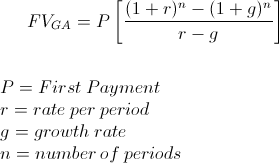

If at the end of the year, put 0 (the default option). If you're putting the money in at the beginning of the year, put in 1.

If, for example, you already have $50,000 in an investment you'll enter -50000 as the PV. This is the present value of your investment or, in other words, the amount you already have in the investment. For example, if you're going to invest $10,000 a year, enter in -10000. Any amount going into the investment should be a negative number, and any amount coming out of the investment should be positive. This is the amount you'll put into the investment on a regular basis each year. If a monthly rate, put in the number of months in the period. If you used an annual rate above, put in the number of years, such as 30. This is the number of periods such as years or months. If you want to do things on a monthly basis, enter in 5%/12. Usually, you can just put in an annual rate of return, such as 5%. This is the interest rate or rate of return. Go down the list to FV and click on it.Ī box will pop up with five values you'll need to fill in.Click on the Formulas tab, then the Financial tab.
Financial calculators future value how to#
How to Calculate Compound Interest Using the Future Value (FV) Formula Fortunately, calculating compound interest is as easy as opening up Excel or Google Sheets and using a simple function - the Future Value Formula. If you plan to retire you want your money to grow.Įstimate how your money will grow by calculating the future value of an investment after years of compounding will help you to make goals and measure your progress toward them. Whether that is an urban legend or not, compound interest is an important financial concept for the investor to understand.


 0 kommentar(er)
0 kommentar(er)
